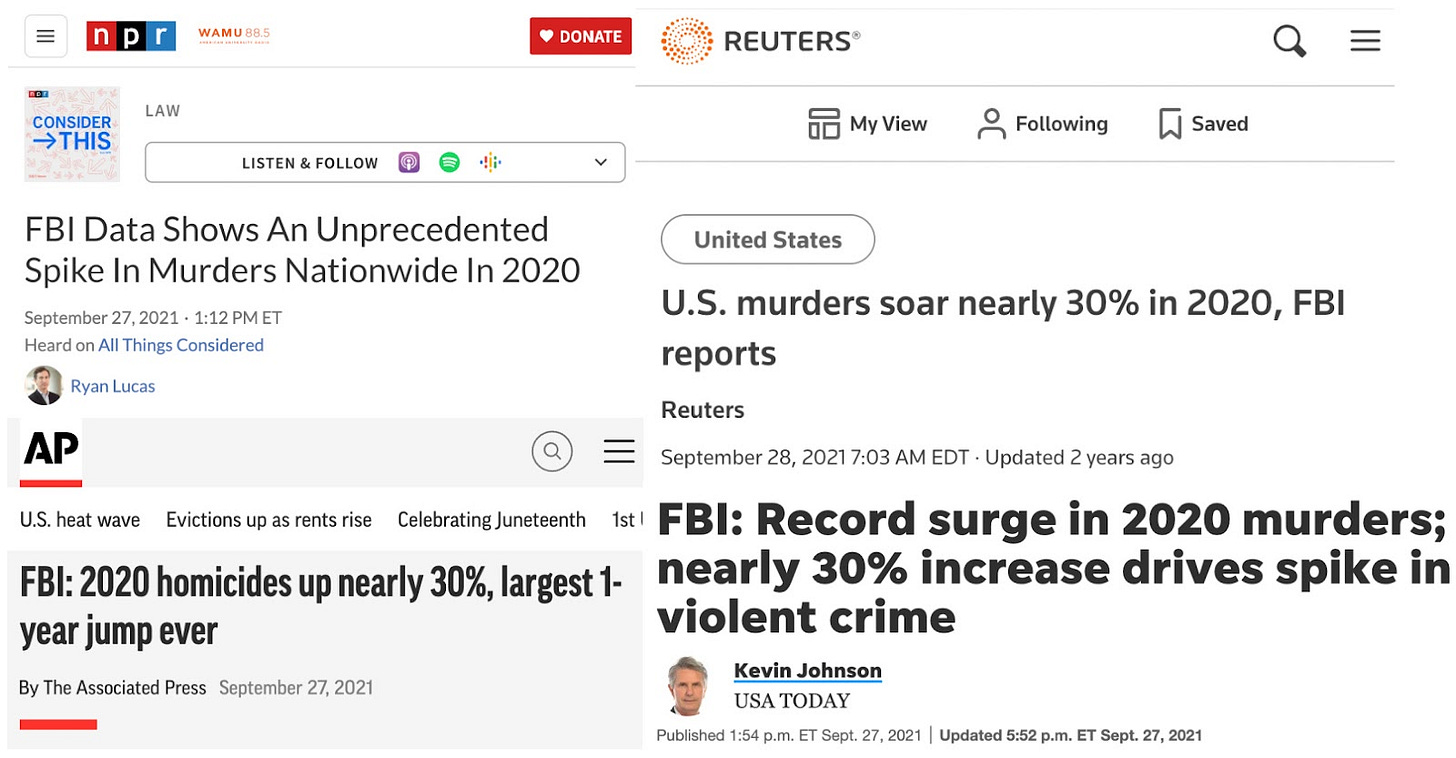US murder rate declines dramatically in 2023 — but you probably haven't heard about it
In 2020, along with the onset of the COVID-19 pandemic, there was a dramatic spike in murders in the United States. This increase in lethal violence, understandably, was covered extensively in national and local media outlets.
Yet, much of this coverage lacked critical context. While the increase in murders was significant, the overall murder rate remained far below its peak in the 1980s and 90s.
The murder rate remained essentially flat in 2021 and declined slightly in 2022. Nevertheless, violent crime became "a key midterm voting issue," as politicians on both sides of the aisle ran thousands of ads focused on the topic.
Beyond election day, the quantity and tenor of crime coverage matters. It shapes public sentiment about crime and ultimately shapes important decisions around public safety budgets, police tactics, and criminal justice policy.
Earlier this month, Jeff Asher, a national expert in criminal justice data, published a piece in the Atlantic revealing that "[m]urder is down about 12 percent year-to-date in more than 90 cities that have released data for 2023, compared with data as of the same date in 2022." Asher described the rapid decrease in the murder rate as "astonishing." In a follow-up piece published in his newsletter, Asher said that, if the trend holds, it will be "the largest decline ever recorded." It would also be the first time ever the murder rate declined by double digits in a single year. (The FBI began keeping statistics in 1961.)
The cause of this decrease is unclear but may be related to the end of the emergency phase of the pandemic and, for most, a return to more routine activities.
The precipitous decline in the murder rate, however, has not merited any dedicated coverage in the nation's largest newspapers, including the New York Times, the Washington Post, USA Today, the Wall Street Journal, and the Associated Press. It also has been rarely mentioned on cable news channels.
In many large cities, the decline in the murder rate, year-to-date, is even more pronounced. Year-to-date murders have declined 40% in Minneapolis, 28% in Atlanta, 26% in Los Angeles, 20% in Philadelphia, and 18% in Baltimore. But local coverage of these declines has been sparse or nonexistent.
Baltimore
On November 4, 2022, the Baltimore Sun published a story on the frustrations of an anti-violence group "as Baltimore heads toward an eighth year in a row of more than 300 homicides." On January 2, 2023, the paper broke the news of the year's "first reported Baltimore killing," a 17-year-old girl who succumbed to gunshot wounds. Since then, the Baltimore Sun has printed at least 10 more stories chronicling murders in Baltimore City and many more stories covering homicides in neighboring counties. A sample of the headlines:
1 teen killed, 4 injured in parking lot shooting Officials, parents lament 'senseless' violence; 'Somebody's baby just got murdered'
Police search for suspect in quadruple shooting that killed 3
Police: Man charged with murder in death of woman found at Lansdowne Middle School
These are all tragic stories that warrant the coverage they received in the Baltimore Sun.
But it is also newsworthy that, through June 10, 2023, homicides in Baltimore are down 18% year-to-date. If the trend continues, Baltimore will finish the year with fewer than 300 homicides.
The Baltimore Sun has not written a piece on the sharp decline in homicides or even mentioned the decline in its other stories about homicides in Baltimore.
Philadelphia
In March, as Philadelphia’s mayoral race was underway, the editorial board of the Philadelphia Inquirer argued that “job one for the next mayor" is "stemming the tide of murders." The authors of the piece acknowledged that while the number of murders dropped 8% in 2022, it was still unacceptably high and "added to the sense of lawlessness across the city.”
So far this year, the Philadelphia Inquirer has published at least 38 stories on local murders and killings.
These stories are all newsworthy, with many of them drawing attention to gun violence. But also true is that as of June 18, 2023, homicides are down 20% this year to date. That fact has never been mentioned in the Philadelphia Inquirer.
While some of the articles briefly note that Philadelphia is on track to have fewer shootings in 2023 than in 2022, only one story focused primarily on the decrease in violent crime. And that story, published in April, focused only on downtown Philadelphia, not the entire city.
Los Angeles
Since the beginning of the year, the Los Angeles Times has published over 60 stories on murders and killings in Southern California and surrounding areas.
A few of these articles acknowledge that the number of people killed this year has dropped compared to last year, but the majority don’t. Through June 10, homicides in Los Angeles are down 26%. To its credit, the Los Angeles Times published an article on June 1 that mentions this decline. But a typical reader of the Los Angeles Times would be far more likely exposed to the drumbeat of weekly murder stories. It's a dynamic that is repeated in media outlets across the country.




What Michael Moore argued in “Bowling for Columbine” 20 years ago is truer than ever: the American media’s obsession with violent crime has resulted in a frightened citizenry that believes guns make us safer.
"If it bleeds, it leads." Murders are sexy. Controversy is sexy. Political gamesmenship is sexy. The truth about certain and specific things? Not sexy.
If it ain't sexy, it ain't news!
/s